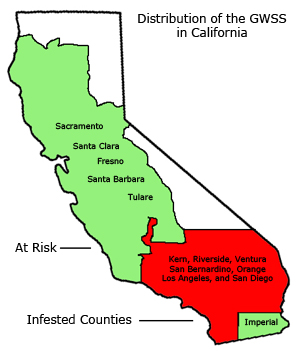Glassy-Winged Sharpshooter, Homalodisca vitripennis
The Situation: The glassy-winged sharpshooter (GWSS), likely introduced from the southeastern U.S. as eggs on nursery stock, was first observed in Orange and Ventura counties in California in 1989. It has a large plant-host range and is especially abundant on citrus.
Damage: GWSS feeds on plants through straw-like mouthparts inserted into the xylem tissue which conducts water throughout the plant. Because nutrients are diluted in xylem fluid, GWSS must process large volumes to meet nutritional needs. Thus, this pest produces copious amounts of watery excreta and are a social nuisance as the liquid rains down from large populations feeding on ornamental trees. In infested citrus orchards, tree canopies take on a white-washed appearance by mid-summer due to the buildup of residues after the evaporation of this watery excreta. Even more important is the capacity for the GWSS to acquire and spread a plant pathogenic bacterium, Xylella fastidiosa. Different strains of this bacterium induce severe diseases in many agricultural and ornamental plants. The best known of these maladies is Pierce's disease of grapevines. In southern California, GWSS spreads the Pierce's disease bacterium and a new strain of X. fastidiosa that induces a lethal disease of oleander named oleander leaf scorch. Other crops at risk include almonds (almond leaf scorch), and alfalfa (alfalfa dwarf), which are infected by the same strain of X.f.thatinduces Pierce's disease, and potentially other ornamental and fruit trees.
Economic Impact: Currently, GWSS is responsible for outbreaks of Pierce's disease in several wine-grape growing areas of California, including Temecula, Bakersfield, Ontario, and Coachella. In ornamental horticulture, an important part of the landscape in the southwest will be lost if oleander leaf scorch continues to spread and resistant oleander varieties are not found. Oleander is found in 20% of all home gardens in California, and is a mainstay of landscapes in shopping centers, parks and golf courses. The California Department of Transportation (Caltrans) maintains oleander in over 2,100 miles of freeway median. It is estimated that Caltrans alone stands to suffer at least a $52 million loss if oleander on highway plantings is lost. In the city of Tustin (Orange County), approximately $200,000 was requisitioned to pay for removal of oleanders maintained on city greenbelts and for replanting other ornamental species. Another huge economic problem lies in the transport of ornamentals by wholesale nurseries as this industry is subjected to rigorous inspections and mandatory insecticide applications to minimize the accidental shipment of GWSS into uninfested areas of California.
Distribution: Since its initial introduction, the numbers of GWSS and associated problems have increased as the insect spreads throughout southern California. The GWSS can now be found in highpopulations in areas of San Diego, Orange, Riverside, San Bernardino, Los Angeles, Ventura, Kern and Santa Barbara counties. GWSS has successfully invaded French Polynesia (1999), Hawaii (2004), Easter Island (2005), and the Cook Islands (2007).
Research:At the University of Californiaon the Riverside, Davis and Berkeley campuses, and at the county level through Cooperative Extension, research is under way to manage GWSS population densities and curtail the potential devastation of GWSS-spread diseases. Studies are aimed at developing better detection methods for the pathogens and reducing vector pressure in affected areas by managing pathogen and vector source hosts. In addition, efforts are concentrating on providing short-term strategies to slow the spread of these diseases while long-term solutions are developed. Short-term strategies include the use of systemic insecticides and behavior modifiers that disrupt acquisition and transmission of the pathogen by GWSS. Long term solutions involve the introduction of biological control agents that attack the eggs of GWSS, techniques that insert genes into host plants that confer resistance or tolerance to X. fastidosa, or other xylem-limited bacteria that interfere with the pathogen's reproduction, movement, and vector transmission.
More Media on the Glassy-Winged Sharpshooter
Center for Invasive Species Research, University of California Riverside
Text provided by Mark S. Hoddle Photos courtesy of CDFA and Mike Lewis
Mark Hoddle, Extension Specialist and Director of Center for Invasive Species Research
mark.hoddle@ucr.edu
Personal Website
Media within CISR is licensed under a Creative Commons Attribution-NonCommercial-NoDerivs 3.0 Unported License. Permissions beyond this scope may be available at www.cisr.ucr.edu/media-usage.



